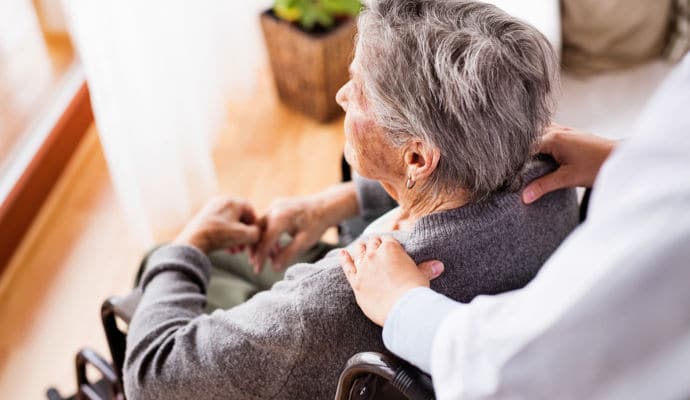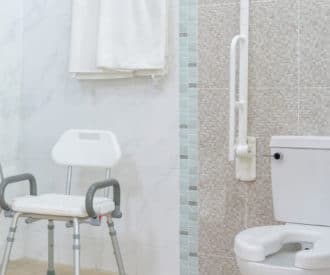
After a stroke, survivors often develop physical disabilities or limitations. Caring Senior Service shares 12 simple home modification tips to help stroke survivors ease back into living at home with greater independence.
Once someone has survived a stroke, transitioning from a hospital or skilled nursing facility back to home is the next challenge.
But too often, the home is not equipped for new disabilities or physical challenges. About one third of stroke survivors are permanently disabled after their stroke, leaving them unable to do many of the things they used to do without assistance.
Before a stroke survivor returns home, it’s important that family caregivers evaluate the home for modifications that can help them transition smoothly.
Below are 12 tips for modifying each room in the house and helping your older adult ease into life at home after a stroke.
The bathroom
1. Install grab bars
The bathroom is one of the most dangerous places for many stroke survivors.
Water and slippery surfaces can cause problems for even the most sure-footed of us, so these surfaces can be especially challenging to someone with physical impairments.
Grab bars in the tub or shower provide stability and can significantly reduce your loved one’s fall risk after a stroke.
Grab bars can also be added next to the toilet for ease in moving from a standing to sitting position.
2. Provide shower chairs and no-skid bath mats and tub decals
In addition to grab bars for stability, tub chairs and non-slip tub decals can help stroke survivors keep their footing to stay safe while bathing.
3. Install walk-in tubs or showers
If you have the means to remodel the bath, a great option to assist your loved one is to convert your existing tub into a walk-in tub or shower.
These eliminate the need for a stroke survivor with physical limitations from having to climb into and out of a tub or shower, which provides additional safety and reduces fall risk.
4. Reorganize to accommodate mobility aids
If your older adult now uses a wheelchair, walker, or other mobility aid, you may need to reorganize shelves, mirrors, and dressing areas to accommodate these items.
You may even need to remove or change the bathroom door so that wheelchairs and walkers can easily fit through the opening.
The bedroom
1. Modify the bed or change the type of bed
Because of mobility issues, a standard bed may be too low for stroke survivors to get into comfortably.
Consider raising the bed using simple bed risers or renting or buying a hospital bed that can be adjusted into a variety of positions.
2. Reorganize dressing areas
Just like in the bathroom, shelves, mirrors and dressing areas in the bedroom might need to be modified to adjust for mobility devices or simply to make it easier on your older adult to sit or stand.
Using easy-glide drawers and lowering closet clothes bars can also help stroke survivors who use a wheelchair.
3. Add dressing aids
If necessary, provide dressing aids that help with their physical limitations like shoe horns, zipper puller and button hook aids, grabbing tools, and shoes that don’t require lacing up.
Stroke survivors often find they aren’t able to move as easily as they once did and these devices make it easier for them to dress independently.
The kitchen
1. Assess major appliances for ease of access and safety concerns
Consider moving your older adult’s favorite food items to lower shelves in the cabinets and refrigerator so they don’t have to reach too high or low to reach them.
Sometimes, stroke survivors can also become desensitized to heat, so providing them access to a microwave or replacing the stove with a lowered electric cooktop can help prevent burns.
2. Add tables and seating
Standing for long periods of time to prepare a meal may no longer be feasible.
Make cooking easier and more comfortable by adding additional chairs and/or small tables that sit lower than standard kitchen countertops.
3. Find kitchen gadgets designed for people with restrictions
Replacing standard kitchen tools with adaptive utensils, rocking knives, contained vegetable choppers and one-handed or lap cutting boards can also give more independence.
Entrances and walkways
1. Add ramps
Even one-story homes often have a few steps at the front door to get into the house.
Even if your older adult isn’t in a wheelchair, converting stairs into a ramp may be needed. Ramps are often helpful to those who have difficulty climbing steps.
2. Clear walkways
Keeping walkways and paths between furniture clear of clutter and cords can help your older adult maneuver more easily throughout the home.
You may also consider rearranging the furniture so they can move around without running into obstacles or potentially tripping.
Financial help for home modifications
If home modifications aren’t in the budget, your local Area Agency on Aging can refer you to non-profit groups who may be able to help.
And check this list for additional organizations that provide home repair assistance.
Recommended for you:
- Dressing After Stroke: Tips to Regain Independence
- Stroke Therapy Exercises for Upper and Lower Body
- 7 Sources of Home Repair Assistance for Seniors
Guest contributor: Caring Senior Service Founder & CEO Jeff Salter began his career in senior care in 1991 working for a home health care agency in Odessa, Texas. Four months later, he started his own senior care service to provide seniors with the non-medical care they need to stay at home. In 2003, Caring Senior Service began offering franchises and today has nearly 50 locations across the United States. For more information on Caring Senior Service, please visit their website at https://www.caringseniorservice.com/
This article wasn't sponsored, but contains some affiliate links. We never link to products or services for the sole purpose of making a commission. Recommendations are based on our honest opinions. For more information, see How We Make Money.
[optin-monster slug=”yxbytm35zhsdfopnw7qk”][optin-monster slug=”jvhyplxmb4umsjazxecn”]




